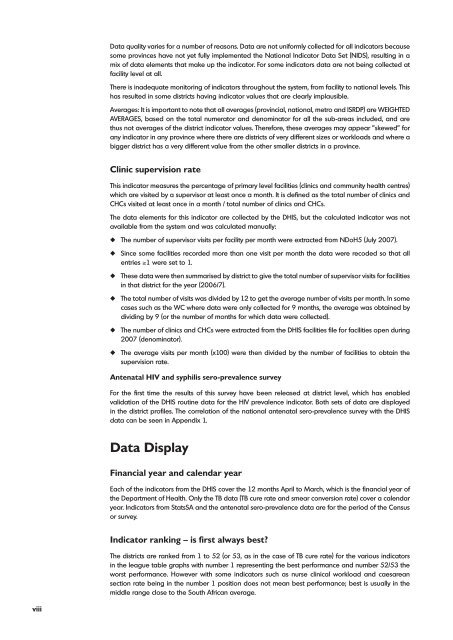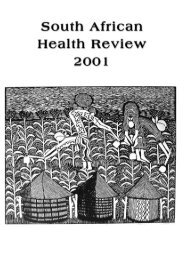DHB 2006/07 - Health Systems Trust
DHB 2006/07 - Health Systems Trust
DHB 2006/07 - Health Systems Trust
You also want an ePaper? Increase the reach of your titles
YUMPU automatically turns print PDFs into web optimized ePapers that Google loves.
Data quality varies for a number of reasons. Data are not uniformly collected for all indicators because<br />
some provinces have not yet fully implemented the National Indicator Data Set (NIDS), resulting in a<br />
mix of data elements that make up the indicator. For some indicators data are not being collected at<br />
facility level at all.<br />
There is inadequate monitoring of indicators throughout the system, from facility to national levels. This<br />
has resulted in some districts having indicator values that are clearly implausible.<br />
Averages: It is important to note that all averages (provincial, national, metro and ISRDP) are WEIGHTED<br />
AVERAGES, based on the total numerator and denominator for all the sub-areas included, and are<br />
thus not averages of the district indicator values. Therefore, these averages may appear "skewed" for<br />
any indicator in any province where there are districts of very different sizes or workloads and where a<br />
bigger district has a very different value from the other smaller districts in a province.<br />
Clinic supervision rate<br />
This indicator measures the percentage of primary level facilities (clinics and community health centres)<br />
which are visited by a supervisor at least once a month. It is defined as the total number of clinics and<br />
CHCs visited at least once in a month / total number of clinics and CHCs.<br />
The data elements for this indicator are collected by the DHIS, but the calculated indicator was not<br />
available from the system and was calculated manually:<br />
◆ The number of supervisor visits per facility per month were extracted from NDoH5 (July 20<strong>07</strong>).<br />
◆ Since some facilities recorded more than one visit per month the data were recoded so that all<br />
entries ≥1 were set to 1.<br />
◆ These data were then summarised by district to give the total number of supervisor visits for facilities<br />
in that district for the year (<strong>2006</strong>/7).<br />
◆ The total number of visits was divided by 12 to get the average number of visits per month. In some<br />
cases such as the WC where data were only collected for 9 months, the average was obtained by<br />
dividing by 9 (or the number of months for which data were collected).<br />
◆ The number of clinics and CHCs were extracted from the DHIS facilities file for facilities open during<br />
20<strong>07</strong> (denominator).<br />
◆ The average visits per month (x100) were then divided by the number of facilities to obtain the<br />
supervision rate.<br />
Antenatal HIV and syphilis sero-prevalence survey<br />
For the first time the results of this survey have been released at district level, which has enabled<br />
validation of the DHIS routine data for the HIV prevalence indicator. Both sets of data are displayed<br />
in the district profiles. The correlation of the national antenatal sero-prevalence survey with the DHIS<br />
data can be seen in Appendix 1.<br />
Data Display<br />
Financial year and calendar year<br />
Each of the indicators from the DHIS cover the 12 months April to March, which is the financial year of<br />
the Department of <strong>Health</strong>. Only the TB data (TB cure rate and smear conversion rate) cover a calendar<br />
year. Indicators from StatsSA and the antenatal sero-prevalence data are for the period of the Census<br />
or survey.<br />
Indicator ranking – is first always best?<br />
The districts are ranked from 1 to 52 (or 53, as in the case of TB cure rate) for the various indicators<br />
in the league table graphs with number 1 representing the best performance and number 52/53 the<br />
worst performance. However with some indicators such as nurse clinical workload and caesarean<br />
section rate being in the number 1 position does not mean best performance; best is usually in the<br />
middle range close to the South African average.<br />
viii

















